Traditionally, bike pedal sizing was not that important to riders. However, many manufacturers are bringing out new sizes for their pedals to cater to the needs of all riders. In this article, we will talk about pedal sizes and how to tell what size you need. By size, we are mainly talking about the platform size. But we will also discuss thread size and spindle length as these are important features of a pedal as well.
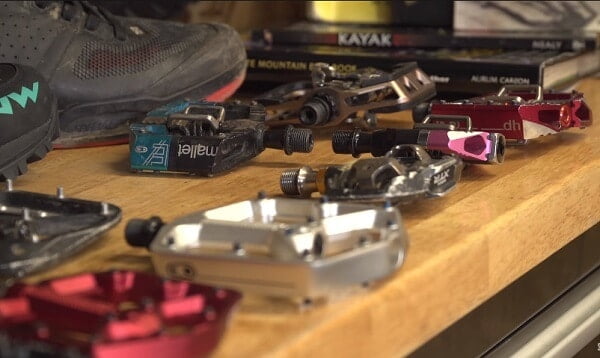
Platform Size
Every pedal manufacturer produces numerous models that may have slightly varying sizes. Some companies now also offer more than one size for the same model. Even among clipless pedals, you can get anything from pedals that are basically only the cleat retention system, to pedals with a large base around the clips. Each rider might have a different preference, but it mainly depends on what terrain you ride and your shoe size.
Riding Style
If you are a downhill rider, you might find larger pedals to be better. When making your way down a slop, you’ll want to be able to move around on the pedals a bit. Also, larger pedals offer better control of the bike and sometimes better grip for the feet. On the other hand, rocky climbs or off-camber trails require more compact pedals for better clearance with the ground. For road riding, smaller pedals are also preferred so that weight can be minimized.
➥ As a beginner, you can choose a Road bike pedal which would help you to achieve peak performance.
Foot/Shoe Size
Next you’ll have to look at the size of your feet. Obviously, those of you with very large feet will need larger pedals, especially if you are using flat pedals. In general, size is less of an issue with clipless pedals. Although, clipless pedals with a small area might cause hotspots to develop. However, keep in mind that a large size is not offered by all brands.
Now some of you might wonder – when weight and clearance are not an issue, should we all just use the largest pedals we can get? Well, that’s completely up to you. If your feet are quite small, a set of large pedals might actually be less grippy since not all the pins come into contact with your shoes.
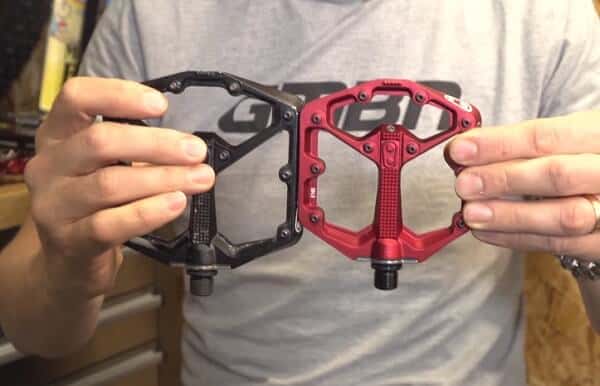
Thread Size
Bike pedals are attached to the crank arms by a thread which may be available in different sizes. The possible thread sizes that you can encounter are the following:-
- 9/16” × 20 tpi (14.28 × 1.27 mm)
- ½” × 20 tpi (12.7 × 1.27 mm)
- 0.55” × 20.32 tpi (14 × 1.25 mm)
Luckily, the majority of all pedals come with a 9/16” thread size with 20 threads per inch. Pretty much all modern adult bikes have this type of thread. Therefore, changing pedals will usually not be a problem.
Pedals with a ½” inch thread can be found only in BMX bikes, kids bikes, and in some cruiser bikes. So if you have one of these bikes, you should check the size before you get a replacement. The 0.55” pedals thread size has become almost obsolete today since no manufacturer uses them anymore. This size was used in older French bikes.
Thread Adaptors
In the rare case that you have pedals and a bike with different thread sizes, you will still be able to use them. A thread adaptor has to be inserted between the pedal and the crank arm to make this possible. There are two types – ½” to 9/16” adaptors and 9/16” to ½” adaptors. Note that using an adaptor will increase the distance between your pedals, giving you a wider stance.
Spindle Length
The spindle length refers to the distance between the crank arm and the center of the pedal. You must choose a spindle length that will be favourable to your body’s mechanics. The longer the spindle length the wider apart your feet will be. Typical values of the spindle length is around 55-65 mm. But before you can decide what spindle length you need, we have to discuss two other things – Q-factor and stance width.
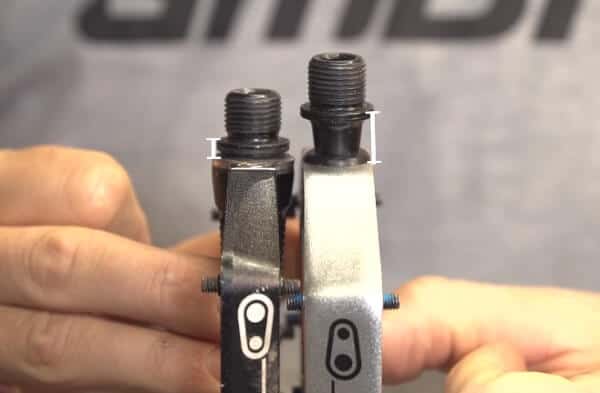
Q-Factor
The Q-factor of a bike is the distance between the outsides of both crank arms. This value also plays a role in determining the width between your feet when riding a bike. The Q-factor may vary from one bike to another depending on the design, construction, and even frame size.
Stance Width
Finally, we have to learn about the stance width. This is basically the distance from the center of one pedal to the center of the other pedal. The position of your feet while pedaling should correspond to the stance width. Having a stance width that is too wide or too narrow is bad for your knees. There is an optimum value which may be different for different cyclists. Ideally, your feet should be directly below your knees. However, some people may feel comfortable with a slightly different position.
Determining Required Spindle Length
First you should find out your preferred stance width. Sit on your bike while holding something for support and place your feet in a position where they are directly below your knees. Get someone to measure the length between the points on your feet where the centers of the pedals should be. This will be the stance width that you should aim for. If they are already aligned then you have the right stance width. Otherwise, you need a longer or shorter spindle.
Then you have to measure your bike’s Q-factor. After that you can calculate the required spindle length using the following formula:-
Spindle length = (Stance width − Q-factor) ÷ 2
The spindle length of your pedals does not have to be exactly equal to the value you get. It can be in the range of ±2 mm.
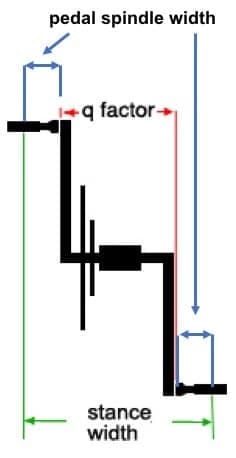
Axle Extenders & Pedal Washers
If you don’t want to buy new pedals but still adjust your stance width, you can do so with the help of axle extenders and pedal washers. Axle extenders can add up to 25 mm to the spindle length. Pedal washers are less drastic and only add around 3 mm of length.
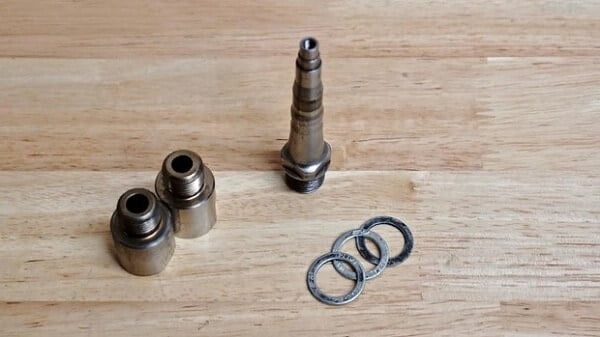
Frequently Asked Questions
Q1. Why is a proper stance width important?
Ans.: Cycling causes a lot of load to be transmitted through the knees. Just in an hour of riding at a cadence of 70 rpm, each knee will experience a load 4200 times. So, you can see how it would add up in the long run. When you ride with a stance width that is either too narrow or too wide, your knees will tend to either track outward or inward at the top portion of the pedal stroke. This can cause issues such as joint pain and a decrease in the efficiency of energy transfer during the entire pedal stroke.
Q2. How can you find the pedal thread size of your bike?
Ans.: There is a very easy way to tell if you need a 9/16” thread or a ½” thread. All you have to do is look at the crank arms of the bike. If you have a 3-piece crank made up of two separate crank arms and a spindle going through the bike frame, then your pedals should have a 9/16” thread. You will need a ½” thread if the cranks are a single unit going through the frame. This is known as a 1-piece crank.
Q3. How can you tell left and right pedals apart?
Ans.: Luckily for us, this is also quite easy since all pedals come with an ‘L’ and ‘R’ marking to distinguish left and right. The right hand pedal should be installed on the drivetrain side and the left hand pedal on the other side. In case your pedals do not have a marking or the marking has worn away, then you will be able to tell by looking at the threads. Hold the pedals up with the spindle pointed towards the ceiling and look at the threads. On the left side pedal, the thread will slope upwards to the left. It will slope upwards and to the right on the right side pedal.
Conclusion
We have provided a lot of details in this article. But no need to feel overwhelmed. Selecting the correct pedal size is mostly about what feels right to you. So, try out a few pedals with different specs and see what works best for you. And if you are content with the pedals that you already have, then there is no need at all to get new ones until you break them.

Thanks for all the great pedal info!
I have an excel 285 air bike the left pedal broke off.I need a replacement can you tell what size i would need and where to get it.thank you.